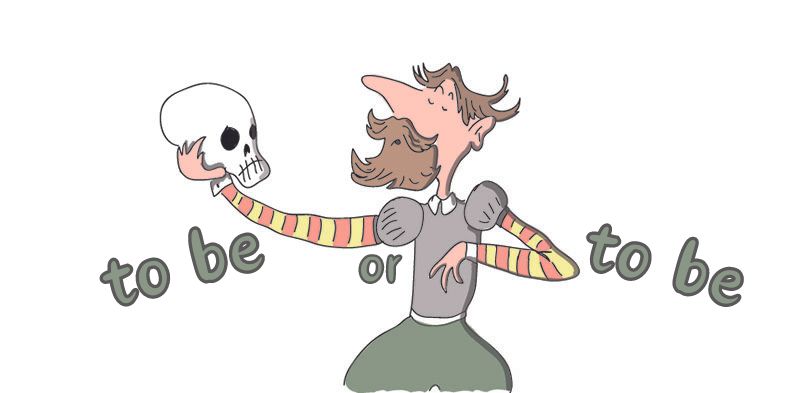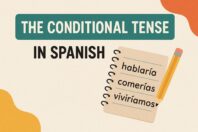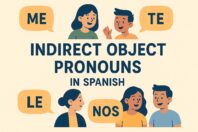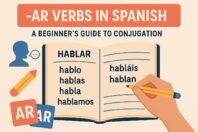A Guide to the Differences Between the Spanish Verbs Ser and Estar

Get our free email course, Shortcut to Conversational.
Have conversations faster, understand people when they speak fast, and other tested tips to learn faster.
More infoTo be or to be? That is the question.
In this post, we explain the difference between the two Spanish verbs for to be: ser vs estar. Spanish students get confused by these a lot, and there’s really no reason to be.
Let’s get right to it.
What is the difference between Ser and Estar?
There are two verbs that mean to be in Spanish: ser and estar.
- Ser is used in a simple way, to talk about WHAT something is (permanent states), to describe characteristics that are an essential part of the thing we’re talking about.
- Estar is used to talk about HOW something is, so we use it for conditions, locations, emotions, and actions (temporary states).

Now let’s compare ser vs estar in a little more detail…
Uses of Ser
More specifically, ser is used for these situations:
- The hour, day, and date
- Place of origin
- Occupation
- Nationality
- Religious or political affiliation
- The material something is made of
- Possession
- Relationship of one person to another
- Where an event is taking place
- Essential qualities (what makes this thing, this thing?)
Uses of Estar
On the other hand, estar is used for:
- Geographic or physical location
- State or condition (like emotions)
- Many idiomatic expressions
- Progressive tenses (-ing in English).

Unsure what to learn next?
Download the exact curriculum that thousands of BaseLang students have used to become fluent in Spanish.
Download Guide Now!
Ser and Estar conjugation
Ser and estar are both irregular verbs, so you’ll need to just memorize their conjugations. We’ll just do a review of the present tense for each one here, since we’ll be seeing this tense in all of our examples below.
Ser present tense conjugation
For all the other tenses of ser, see our detailed post with every conjugation of Ser.
| yo soy | nosotros, nosotras somos |
| tú eres | vosotros, vosotras sois |
| él, ella, usted es | ellos, ellas, ustedes son |
Estar present tense conjugation
For all the other tenses of estar, see our detailed post with every conjugation of Estar.
| yo estoy | nosotros, nosotras estamos |
| tú estás | vosotros, vosotras estáis |
| él, ella, usted está | ellos, ellas, ustedes están |
Ser vs Estar: A Mountain of Examples
Ultimately, the best way to understand the difference between ser and estar is to see a TON of example situations that show which verb to use.
So we present you just that: a mountain of detailed examples to compare ser and estar.
Situation 1: Talking about a person
SER
María is a happy person.
María es una persona muy alegre.
Being happy is a part of María’s personality, so it’s a constant. It’s part of what María is, so we use ser.
ESTAR
María is in a good mood.
María está de buen humor.
One’s mood always changes throughout the day, and we experience different emotions in one day, so, we use estar because we are talking about a condition.
Situation 2: Talking about the location of an event
SER
The soccer game is in the Stadium.
El juego de fútbol es en el estadio.
Here we are referring to where the event is taking place.
ESTAR
The Stadium is downtown.
El estadio está en el centro de la ciudad.
Here we are referring to the physical location of the stadium (which sounds permanent, but we use estar for locations).
Situation 3: Describing a relationship between two people
SER
Carlos and Gabriela are spouses.
Carlos y Gabriela son esposos.
In this case, we are describing their relationship to each other.
ESTAR
Carlos and Gabriela are married.
Carlos y Gabriela están casados.
Here, we talk about their marital status, which is a condition or a state.
Situation 4: Describing appearance
SER
She is very pretty.
Ella es muy bonita.
Here we’re describing what can be considered a permanent characteristic: she’s intrinsically pretty.
ESTAR
She is very beautiful tonight.
Ella está muy hermosa esta noche.
Here we’re describing a non-permanent characteristic. Maybe she’s not usually this pretty!
Situation 5: Location
SER
We are from NYC.
Nosotros somos de NYC.
We use ser to describe the subject’s origin (permanent).
ESTAR
We are on a journey to Australia.
Nosotros estamos en un viaje por Australia.
We use estar to describe the subject’s current location (non-permanent).
Situation 6: Marital status
SER
She is a mother.
Ella es una madre.
Ser confers on our subject a permanent characteristic.
ESTAR
She is married.
Ella está casada.
Estar confers on our subject a non-permanent characteristic (with her marriage though, hopefully it is!).
Situation 7: Talking about fruits
SER
The apple is green. (color of the fruit)
La manzana es verde.
Here we give a characteristic of the fruit. It’s not green just for a moment, that’s part of what it is.
ESTAR
The banana is green. (it’s not ripe)
La banana está verde.
The banana is only temporarily green in this case, because it’s not ripe.
Situation 8: Locality and nationality
SER
I am from Colombia.
Yo soy de Colombia.
We are talking about a characteristic: where I am from. We use ser with a country or nationality.
ESTAR
I am in Spain.
Yo estoy en España.
We are talking about a condition. I am in a place (a specific country) at the current moment.
Situation 9: Food
SER
The soup is tasty at that restaurant.
En ese restaurante la sopa es muy sabrosa.
We are giving a characteristic to the soup from that restaurant specifically.
ESTAR
The soup is cold.
La sopa está fría.
We are talking about the state of the soup, which in this case is cold.
Situation 10: Describing people using temperature words
SER
She is cold. (her personality)
Ella es fría.
In this case, when we use the verb ser and the adjective cold, the sentence takes a figurative connotation meaning that she has a cold personality, without feelings.
ESTAR
She is cold. (her body temperature)
Ella está fría.
In this case, when we use the verb estar and the adjective cold, the sentence takes the literal meaning of the word cold related to very low temperature. Her body is cold.
Situation 11: Talking about dead people
SER
Santiago is a dead man.
Santiago es hombre muerto.
Somebody very dangerous has threatened Santiago’s life. He’s not actually dead yet but probably he will be soon. In this case we should use ser, and the complement “hombre muerto.”
ESTAR
John Lennon is dead.
John Lennon está muerto.
We started by saying that ser is used for permanent situations and estar for transitory situations, and that is generally the rule. But rules usually have exceptions and this is one of them. Being dead is a permanent state. But the right verb to use with being dead is estar. We cannot say “John Lennon es muerto.”
Situation 12: Talking about being young
SER
My grandpa is young, he’s only 45.
Mi abuelo es joven, apenas tiene 45 años.
In this case, we use the verb ser when we want to say that the person is actually young.
ESTAR
My grandfather is young for his age.
Mi abuelo está joven para su edad.
In this case we use estar, when we want to say that the person looks younger than their age.
Situation 13: Being athletic or doing exercises
SER
Renata is a very athletic person.
Renata es una persona muy deportiva.
Being athletic is part of who Renata is as a person, not a temporary state, so we use ser.
ESTAR
Renata is very tired of doing exercises.
Renata está muy cansada de hacer ejercicio.
In this example we are talking about what Renata feels right now about what she is doing, so we use estar.
Situation 14: Talking about beauty
SER
Paula is beautiful.
Paula es hermosa.
In this example we’re talking only about Paula’s permanent beauty.
ESTAR
Paula is beautiful today.
Paula está hermosa hoy.
In this example we’re describing Paula’s beauty at a particular moment.
Situation 15: Places
SER
Edward is from Venezuela.
Edward es de Venezuela.
Edward is from Venezuela, meaning that’s a permanent part of who he is.
ESTAR
Edward is in Barcelona.
Edward está en Barcelona.
Edward is in Barcelona right now, but he won’t always be. It’s not part of him.
Situation 16: To identify a person
SER
Who is the teacher?
¿Quién es la profesora?
When we ask about a person’s profession we use ser, as it’s considered a part of who they are.
ESTAR
Where is the teacher?
¿Dónde está la profesora?
This is the standard way to ask where someone is now (which is temporary).
Situation 17: Permanent or temporary states of an object
SER
The ice is cold.
El hielo es frío.
The ice is always cold, because if it weren’t cold, it wouldn’t be ice. Coldness is part of what it is.
ESTAR
The water is cold.
El agua está fría.
In the case of water’s temperature, it depends if it’s in the fridge or under the sun. Its state can change, so it is temporary.
Situation 18: To describe an object
SER
The seatbelts are important.
Los cinturones de seguridad son importantes.
This is stating a quality of the seatbelt: that it’s important. It’s never not important, so this is a characteristic of the seatbelt and thus we use ser.
ESTAR
The seatbelts are in the car.
Los cinturones de seguridad están en el carro.
Here we’re talking about where the seatbelt is. We use estar for locations.
Situation 19: Permanent state regarding a profession and a place of work
SER
I am an astronaut.
Soy un astronauta.
We use ser for professions because they are considered a part of who the person is.
ESTAR
I am in space.
Estoy en el espacio.
In this case, we’re talking about where the astronaut is at a particular time.
Situation 20: Talking about a place or a specific characteristic
SER
I am a sleepy person.
Yo soy una persona dormilona.
Here we are talking about a permanent characteristic of the person, so we use ser.
ESTAR
I am in bed.
Estoy en cama.
Again, locations always use estar. You’re not always in bed.
Situation 21: Using adjectives for attributes or status
SER
The apple is red.
La manzana es roja.
The adjective is used to point out a specific feature about something that makes it unique or stand out from the rest.
ESTAR
The apple is ripe.
La manzana está madura.
Here, we use the verb estar to indicate the current status of something.
Situation 22: Permanent or temporary state of being
SER
I am a happy person.
Yo soy una persona feliz.
This is a permanent state of being. Part of someone’s personality. It is just the way that person is most of the time.
ESTAR
I am happy.
Yo estoy feliz.
This is a specific mood for a shorter period of time. It is temporary, so the state of happiness could change anytime.
Situation 23: Watching the soccer game
SER
This team is very good.
Este equipo es muy bueno.
We use ser to describe the quality of the team, since we consider it a permanent characteristic.
ESTAR
I am watching the soccer game at the stadium.
Yo estoy viendo el juego de fútbol en el estadio.
Here estar is used with the gerund to create the Spanish “-ing” form: the present progressive. It describes an action that is happening in one place, at a determined time. It’s temporary.
Situation 24: Describing food and eating
SER
It is pizza that they are eating now.
Es pizza lo que ellos comen ahora.
Here we’re explaining exactly what kind of food it is.
ESTAR
They are eating pizza in the park.
Ellos están comiendo pizza en el parque.
Here we’re explaining what they are doing right now. We always use estar as the auxiliary verb to form the present progressive, equivalent to using “-ing” in English.
Situation 25: At a party
SER
This is a retro party.
Esta fiesta es retro.
We have to use ser to describe what kind of party it is.
ESTAR
This party is really fun.
Esta fiesta está realmente divertida.
We have to use estar to describe the moment.
Situation 26: Talking about your mother
SER
She is my mom.
Ella es mi madre.
This example describes the relationship between the mother and her son or daughter, and this relationship won’t change in time.
ESTAR
My mom is sad.
Mi mamá está triste.
Here we’re just mentioning the mood that the mom is in right now.
Situation 27: Talking about a person
SER
Javier is catholic.
Javier es católico.
Religious beliefs are an intrinsic part of a person.
ESTAR
Javier is at the church.
Javier está en la iglesia.
Estar is for locations, since Javier is just in the church right now. You’ve got this by now, right?
Situation 28: Describing a country
SER
Colombia is a big country.
Colombia es un país grande.
Here we are talking about an unchanging characteristic of Colombia. It’s not going to change sizes anytime soon.
ESTAR
Colombia is progressing.
Colombia está progresando.
Here we are talking about the current state of the country.
Situation 29: Talking about a person’s job
SER
He is a waiter.
Él es mesero.
We use ser because someone’s profession is a characteristic of the person.
ESTAR
The waiter is writing the order.
El mesonero está escribiendo la orden.
Here we’re referring to an action that’s currently in progress by using the present progressive “-ing” form.
Situation 30: Talking about someone
SER
She is a fighter.
Ella es peleona.
We use ser since this is a characteristic of the person. It’s something that can’t change easily.
ESTAR
My girlfriend is fighting with me.
Mi novia está peleando conmigo.
We use estar in this second example because the situation can change in a moment. Fighting is not something that will be happening forever!

Unsure what to learn next?
Download the exact curriculum that thousands of BaseLang students have used to become fluent in Spanish.
Download Guide Now!
(PS – to go beyond the present tense of ser vs estar, make sure to read our Beginner’s Guide to Ser vs Estar in the Past Tense.)
Ser vs Estar Practice Quiz
Fill in the blanks using ser or estar according to each image:
Ser vs Estar practice: Answer key
- Antonio es ingeniero.
- Ellos están en el centro comercial.
- Joaquín y Camila están corriendo.
- El edificio es alto.
- Brasil es grande.
- Andrés y Joana son novios.
- Lina está conduciendo ahora.
- Anna está en la playa.











